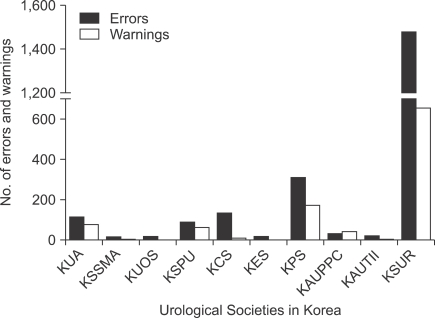Korean J Urol.
2011 Feb;52(2):142-146.
Analysis of Content Legibility for Smartphones of Websites of the Korean Urological Association and Other Urological Societies in Korea
- Affiliations
-
- 1Department of Urology, Hanyang University College of Medicine, Seoul, Korea.
- 2Department of Urology, Eulji Hospital, Eulji University School of Medicine, Seoul, Korea. swleepark@gmail.com
Abstract
- PURPOSE
We performed an analysis of the smartphone legibility of the websites of the Korean Urological Association (KUA) and other urological societies.
MATERIALS AND METHODS
This study was conducted on the websites of the KUA and nine other urological societies. Each website was accessed via iPhone Safari and Android Chrome, respectively, to evaluate the establishment and readability of the mobile web pages. The provision of Really Simple Syndication (RSS) feeds by the websites and whether the websites had Twitter and Facebook accounts were evaluated. In addition, a validation test on the web standards was performed by using the World Wide Web Consortium (W3C(R)) Markup Validation Service, and subsequently the numbers of errors and warnings that occurred were analyzed.
RESULTS
When accessed via Safari, two websites were legible, four were somewhat legible, and four were somewhat illegible. When accessed via Chrome, two websites were legible, six were somewhat legible, and two were somewhat illegible. One website provided an RSS feed and two websites managed members via separate Twitter accounts. No website supported mobile web pages. The result of the W3C(R) Markup Validation test on 10 websites showed a mean error rate of 221.6 (range, 13-1,477) and a mean warning rate of 127.13 (range, 0-655).
CONCLUSIONS
The smartphone legibility level of the websites of urological societies was relatively low. Improved smartphone legibility and web standard compliance of the websites of urological societies are required to keep up with the popularity of smartphones.
MeSH Terms
Figure
Reference
-
1. Oehler RL, Smith K, Toney JF. Infectious diseases resources for the iPhone. Clin Infect Dis. 2010; 50:1268–1274. PMID: 20233061.
Article2. Raento M, Oulasvirta A, Eagle N. Smartphones: an emerging tool for social scientists. Sociol Methods Res. 2009; 37:426–454.3. Kovic I, Lulic I, Brumini G. Examining the medical blogosphere: an online survey of medical bloggers. J Med Internet Res. 2008; 10:e28. PMID: 18812312.
Article4. Wright A, Bates DW, Middleton B, Hongsermeier T, Kashyap V, Thomas SM, et al. Creating and sharing clinical decision support content with Web 2.0: issues and examples. J Biomed Inform. 2009; 42:334–346. PMID: 18935982.
Article5. Wu WG, Li J. RSS made easy: a basic guide for librarians. Med Ref Serv Q. 2007; 26:37–50. PMID: 17210548.6. Muin M, Fontelo P. Technical development of PubMed interact: an improved interface for MEDLINE/PubMed searches. BMC Med Inform Decis Mak. 2006; 6:36. PMID: 17083729.
Article7. Brusco JM. Using smartphone applications in perioperative practice. AORN J. 2010; 92:503–508. PMID: 21040814.
Article8. Jo HS, Hwang MS, Lee H. Market segmentation of health information use on the Internet in Korea. Int J Med Inform. 2010; 79:707–715. PMID: 20810307.
Article9. Sandars J, Schroter S. Web 2.0 technologies for undergraduate and postgraduate medical education: an online survey. Postgrad Med J. 2007; 83:759–762. PMID: 18057175.
Article10. Eysenbach G. Medicine 2.0: social networking, collaboration, participation, apomediation, and openness. J Med Internet Res. 2008; 10:e22. PMID: 18725354.
Article11. Steinberg PL, Wason S, Stern JM, Deters L, Kowal B, Seigne J. YouTube as source of prostate cancer information. Urology. 2010; 75:619–622. PMID: 19815255.
Article12. Pandey A, Patni N, Singh M, Sood A, Singh G. YouTube as a source of information on the H1N1 influenza pandemic. Am J Prev Med. 2010; 38:e1–e3. PMID: 20171526.
Article13. Sood A, Sarangi S, Pandey A, Murugiah K. YouTube as a Source of Information on Kidney Stone Disease. Urology. 2010; Epub ahead of print.
Article14. Murugiah K, Vallakati A, Rajput K, Sood A, Challa NR. YouTube as a source of information on cardiopulmonary resuscitation. Resuscitation. 2010; Epub ahead of print.
Article15. Abbasi K. Journals join the podcast revolution. J R Soc Med. 2006; 99:329. PMID: 16816249.
Article16. Boulos MN, Maramba I, Wheeler S. Wikis, blogs and podcasts: a new generation of Web-based tools for virtual collaborative clinical practice and education. BMC Med Educ. 2006; 6:41. PMID: 16911779.
Article19. Fragoulis KN, Vardakas KZ, Falagas ME. Open access World Wide Web resources on urogenital infections. Nephrol Dial Transplant. 2007; 22:3046–3047. PMID: 17575311.
Article20. Chew C, Eysenbach G. Pandemics in the age of Twitter: content analysis of Tweets during the 2009 H1N1 outbreak. PLoS One. 2010; 5:e14118. PMID: 21124761.
Article21. Martens E. Twitter for scientists. ACS Chem Biol. 2010; 5:149. PMID: 20166757.22. Landman MP, Shelton J, Kauffmann RM, Dattilo JB. Guidelines for maintaining a professional compass in the era of social networking. J Surg Educ. 2010; 67:381–386. PMID: 21156295.
Article23. Scanfeld D, Scanfeld V, Larson EL. Dissemination of health information through social networks: twitter and antibiotics. Am J Infect Control. 2010; 38:182–188. PMID: 20347636.
Article24. Garner J, O'Sullivan H. Facebook and the professional behaviours of undergraduate medical students. Clin Teach. 2010; 7:112–115. PMID: 21134159.
Article25. Mobile bingbang and the future of business management. CEO information. 2010. (760):Samsung Economic Research Institute;p. 1–2.
- Full Text Links
- Actions
-
Cited
- CITED
-
- Close
- Share
- Similar articles
-
- The Current Status of Development of Korean Clinical Practice Guidelines in Urology
- Test Item Analysis of Selection Type in Board Examination of Urology and Counterplan
- Assessment of Bladder Function in Adults with Cerebral Palsy; A Preliminary Study
- Twenty-two-year incidence trend of urological cancers in the Republic of Korea: 1999–2020
- Comprehensive Molecular Characterization of Urological Malignancies: Literature Review of Landmark Studies


